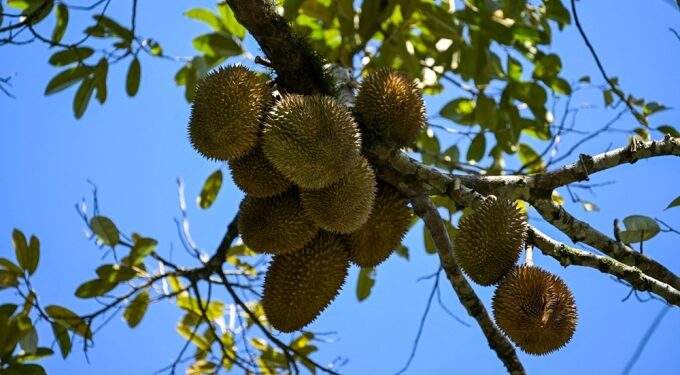Central Sulawesi Province is home to Parigi Moutong, a regency recognized for its production of Monthong durians – a variety that originated from Thailand. While frozen Monthong durians from Indonesia are already sold in China, they are exported through Thailand.
But now, efforts are underway to establish a direct supply chain.
Just last week, Chinese customs officials visited the country to inspect durian plantations and packing facilities, likely to see if the “durian export cooperation” can move forward, the South China Morning Post reported, citing Indonesian local media.
Given Indonesia’s large durian industry, exporting to China could unlock a lucrative new market.
Muhammad Tahir, director of PT Ammar Durian Indonesia, an exporter in Parigi Moutong, said it usually takes a month to ship the fruit to China via Thailand.
“If we can go directly from Pantoloan port (in Palu in Central Sulawesi) to China, it will only take about a week,” he told CNA, adding that shipping costs might also be cut in half compared to current rates.
If a direct shipping route is established, the company expects to export 50 containers of the stinky fruit to China annually, up from 30 last year.
And businesses are not the only ones looking forward to the potential trade, as Chinese consumers are also intrigued.
Zhao Yu, a 38-year-old finance professional in Shanghai, said he would “first go and try one” but would check the price beforehand.
However, Indonesia may not be ready to supply the Chinese market’s demand right away, according to analysts.
The country ranks among the world’s top durian producers, with an output of 1.83 million tons in 2023, but the bulk of its output is consumed locally.
Meanwhile, China has enforced strict export regulations for durians that Indonesian farmers and suppliers must comply with.
These include Good Agricultural Practices, Good Handling Practices, and Good Manufacturing Practices.
Central Sulawesi has around 30,000 hectares under the fruit, but only 10% of them have received official certification. The majority of farmers there still rely on simple farming techniques.
Logistical challenges might also make it difficult for Indonesian durians to compete in China, according to Sigit Puruwanto, a durian expert.
“Durian can only survive for a maximum of five days before it ripens, so being closer to China gives other countries a major advantage,” he said, as quoted by The Jakarta Post.
Indonesian officials have suggested that the country may seek to directly export frozen durians at first since they are cheaper than fresh ones and carry lower food safety risks.
The country’s Ministry of Agriculture has reportedly selected 422 villages nationwide for durian farming.
Nukila Evanty, an Indonesia-based member of the advisory board at the Asia Centre research institute, said there is optimism that these durians will be exported to China.
Rusdy Mastura, Central Sulawesi’s governor, said his province will participate in exporting the fruit to China.
“We certainly do not want to waste this opportunity,” he said, as quoted by Xinhua News Agency.
Last year, China imported a record 15.6 million tons of durians worth US$6.99 billion, up 4.1% in value and 9.4% in volume from 2023.
Of these, Thailand accounted for $4 billion and Vietnam for $2.9 billion. The Philippines and Malaysia followed with $32.5 million and $5.7 million, respectively.



